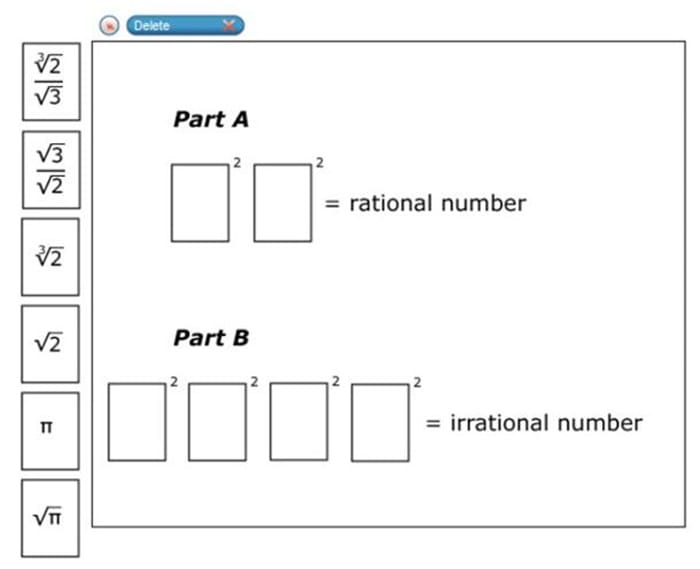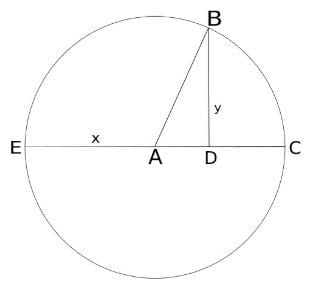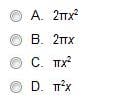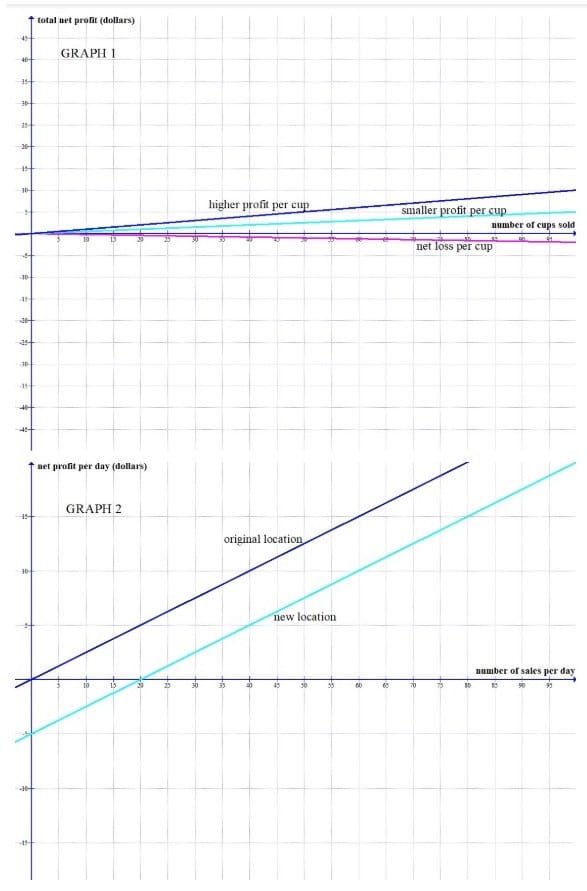SBAC Online Practice Questions and Answers
DRAG DROP
Cheryl claims that any irrational number squared will result in a rational number.
Part A
Drag an irrational number into the first response box that when squared will result in a rational number.
Part B
Drag an irrational number into the second response box that when squared will result in an irrational number.
Select and Place:

FILL BLANK
Read the text and answer the question.
Moving to the Back of Beyond
When my parents said the three of us were moving out to California, to a place just north of Los Angeles, my mind immediately went to thoughts of Disneyland and Hollywood, glitz and glamour. I imagined a Rodeo Drive shopping spree to
pick out a bikini for the endless days I would be spending on the beach. However, I’d forgotten about my parents’ penchant for the unconventional; they’re definitely “the road less traveled” kind of people. Mom had a gopher snake for a pet
when she was younger, and Dad was never happier than when he was climbing near-vertical cliffs that only mountain goats could love. These are not city folk.
They had chosen to buy a 900-square-foot cabin under a 250-year-old oak tree in the high chaparral1 forest out in the back of beyond – so far away from Los Angeles that you couldn't even see the glow of the lights at night. When I first saw
where we were going to live, I vacillated between feeling terrified and excited. This would be an adventure, for sure. But this was no camping trip where you could go home to civilization after a few days of roughing it; this was home, and
roughing it was the new normal.
On move-in day, we drove fifteen miles out from Antelope Valley – where the nearest grocery store was located – on a two-lane road past llamas, cattle, and horses. Up and up we went, until finally we turned down a dirt road and headed into
a canyon full of towering Coulter pines, blue-green sagebrush, and ancient canyon live oaks. I didn't know the names of these plants then, of course; I learned them later. That first day all I saw then was a million shades of green.
We parked under an oak tree that shaded our cabin and a front yard of rock, sand, and sagebrush twice as large as the cabin itself. On the stone staircase that led to the front door, black lizards interrupted their push-ups to twist their heads
and eye us as we passed. Scrub jays squawked and hummingbirds zoomed past the eaves, scolding us with their territorial calls.
No cars roared past. No radios blared from a neighbor's house. There were no neighbors – no human neighbors, anyway.
Our new home consisted of one bedroom, one bathroom, and one big room for everything else. A fireplace in the corner of the big room would be our sole source of heat in the winter. A swamp box (cooler) would blow a breeze over a big
damp pad to keep us cool all summer, or so my father said. But it was early autumn that day, and the temperature was perfect in the shade of the oak tree. Our oak tree, I thought; I was settling in.
Mom wiped a layer of grime off the kitchen counter and muttered about getting a bottle of bleach on our next trip into town. That was the beginning of an important lesson about living in the back of beyond: you don't just zip over to the local
convenience store anytime you need something out here. You have to make a careful list and check it twice so that you don't forget anything, because anywhere is a long way from here.
On my first walk around the property, I saw two horned toads, a red-tailed hawk, and some deer tracks. I wondered what else I might find deeper and higher in the canyon. Dad told me the real estate agent had mentioned that coyotes,
bobcats, mountain lions, rattlesnakes, and even bears roamed these hills. To my surprise, I found I couldn't wait to see them. All of them. I felt my feet taking root in the earth, claiming this place as home.
With no street lamps timed to turn on at sunset, when night came it was darker than anything I had ever experienced. Mom and I went out to look at the stars while Dad tried to unplug the ancient toilet. In the city, or even in the suburbs where
I had lived before, you could see only the brightest stars in the sky. But out here, it was like being in a planetarium, except there were no labels typed onto our sky. The sheer number and spread of stars was awe-inspiring.
That first night, we slept on air mattresses on the living room floor because the movers had not yet arrived. There were no curtains on the windows, so when the moon rose, it shone in as if moonbeams were an integral part of the cabin.
Eventually, I moved into the bedroom and Mom and Dad got a foldout bed for the living room. Over the next few months, I began to count the passage of time in full moons rather than by the pages of a calendar, and for the first time I really
noticed the days growing shorter in winter and longer in summer.
It's hard to believe, but we’ve been here for six years now. I’ve been going to school in the valley, but I feel most at home up here with my wild fellow canyon dwellers. Soon, I will have to leave home for college, and I’m a little afraid of the
culture shock I’m sure I will feel when I move back to civilization. Soon I’ll be walking on pavement and well-mowed grass again, rooming with strangers, and eating meals in a cafeteria crowded with more people than live within twenty miles of
this house. But I know I will come back. The back of beyond is home now.
1. chaparral: a dense thicket of shrubs and small trees
Click the two sentences that best support the inference that the narrator's expectations before the move were based on a kind of fantasy.
When my parents said the three of us were moving out to California, to a place just north of Los Angeles, my mind immediately went to thoughts of Disneyland and Hollywood, glitz and glamour. I imagined a Rodeo Drive shopping spree to pick out a bikini for the endless days I would be spending on the beach. However, I’d forgotten about my parents’ penchant for the unconventional; they’re definitely “the road less traveled” kind of people. Mom had a gopher snake for a pet when she was younger, and Dad was never happier than when she was younger, and Dad was never happier than when he was climbing near-vertical cliffs that only mountain goats could love. These are not city folk.
A.
See explanation below.
Read the text attached.
"Declaration of Conscience" by Margaret Chase Smith June 1, 1950
Mr. President, I would like to speak briefly and simply about a serious national condition. It is a national feeling of fear and frustration that could result in national suicide and the end of everything that we Americans hold dear. It is a condition
that comes from the lack of effective leadership either in the legislative branch or the executive branch of our government...
...I speak as a Republican. I speak as a woman. I speak as a United States senator. I speak as an American...
...I think that it is high time for the United States Senate and its members to do some real soul searching and to weigh our consciences as to the manner in which we are performing our duty to the people of America and the manner in which
we are using or abusing our individual powers and privileges.
I think that it is high time that we remembered that we have sworn to uphold and defend the Constitution. I think that it is high time that we remembered that the Constitution, as amended, speaks not only of the freedom of speech, but also of
trial by jury instead of trial by accusation.
Whether it is a criminal prosecution in court or a character prosecution in the Senate, there is little practical distinction when the life of a person has been ruined.
"The Basic Principles of Americanism"
Those of use who shout the loudest about Americanism in making character assassinations are all too frequently those who, by our own words and acts, ignore some of the basic principles of Americanism ?
The right to criticize.
The right to hold unpopular beliefs.
The right to protest.
The right of independent thought.
The exercise of these rights should not cost one single American citizen his reputation or his right to a livelihood nor should he be in danger of losing his reputation or livelihood merely because he happens to know someone who holds
unpopular beliefs. Who of us does not? Otherwise none of us could call our souls our own. Otherwise thought control would have set in.
The American people are sick and tired of being afraid to speak their minds lest they be politically smeared as "Communists" or "Fascists" by their opponents. Freedom of speech is not what it used to be in America. It has been so abused by
some that it is not exercised by others.
The American people are sick and tired of seeing innocent people smeared and guilty people whitewashed. But there have been enough proved cases...to cause nationwide distrust and strong suspicion that there may be something to the
unproved, sensational accusations.
A Challenge to the Republican Party
As a Republican, I say to my colleagues on this side of the aisle that the Republican party faces a challenge today that is not unlike the challenge that it faced back in Lincoln's day. The Republican Party so successfully met that challenge that
it emerged from the Civil War as the champion of a united nation - in addition to being a party that unrelentingly fought loose spending and loose programs....
The Democratic administration has greatly lost the confidence of the American people by its complacency to the threat of communism here at home and the leak of vital secrets to Russia through key officials of the Democratic administration.
There are enough proved cases to make this point without diluting our criticism with unproved charges.
Surely these are sufficient reasons to make it clear to the American people that it is time for a change and that a Republican victory is necessary to the security of this country.... Yet to displace it with a Republican regime embracing a
philosophy that lacks political integrity or intellectual honesty would prove equally disastrous to this Nation. The nation sorely needs a Republican victory. But I do not want to see the Republican party ride to political victory... [using] fear,
ignorance, bigotry, and smear... I do not want to see the Republican party win that way. While it might be a fleeting victory for the Republican party, it would be a more lasting defeat for the American people. Surely it would ultimately be
suicide for the Republican party and the two-party system that has protected our American liberties from the dictatorship of a one-party system.
As members of the minority party, we do not have the primary authority to formulate the policy of our government. But we do have the responsibility of rendering constructive criticism, of clarifying issues, of allaying fears by acting as
responsible citizens.
As a woman, I wonder how the mothers, wives, sisters, and daughters feel about the way in which members of their families have been politically mangled in Senate debate - and I use the word "debate" advisedly...
I do not like the way the Senate has been made a rendezvous for vilification, for selfish political gain at the sacrifice of individual reputations and national unity. I am not proud of the way we smear outsiders from the floor of the Senate and hide behind the cloak of congressional immunity and still place ourselves beyond criticism on the floor of the Senate.
As an American, I am shocked at the way Republicans and Democrates alike are playing directly into the Communist design of "confuse, divide, and conquer." As an American, I don't want a Democratic administration "whitewash" or "coverup" any more than I want a Republican smear or witch hunt.
As an American, I condemn a Republican Fascist just as much as I condemn a Democrat Communist. I condemn a Democrat Fascist just as much as I condemn a Republican Communist. They are equally dangerous to you and me and to our country. As an American, I want to see our nation recapture the strength and unity it once had when we fought the enemy instead of ourselves.
It is with these thoughts that I have drafted what I call a Declaration of Conscience. I am gratified that the senator from New Hampshire, the senator from Vermont, the senator from Oregon, the senator from New York, the senator from Minnesota and the senator from New Jersey have concurred in that declaration and have authorized me to announce their concurrence.
Read this selection from the attached text. What is the central idea of this section? "I do not like the way the Senate has been made a rendezvous for vilification, for selfish political gain at the sacrifice of individual reputations and national unity. I am not proud of the way we smear outsiders from the floor of the Senate and hide behind the cloak of congressional immunity and still place ourselves beyond criticism on the floor of the Senate."
A. The speaker supports the idea of national unity at all costs. If this means needing to put forth one face while acting differently behind closed doors, so be it. The top consideration is the safety and security of the nation.
B. The speaker disagrees with the behavior of her colleagues in the Senate. She is disturbed by the negative energy and selfish political motivation she sees in some of her colleagues and suggests a need for transparency and for all people of the United States, including the politicians, to be held to the same standard of decorum.
C. The speaker wants to get rid of corrupt politicians she sees as taking advantage of the American people and who threaten national unity. She is tired of the lies and the negativity and is calling for her colleagues who behave badly to be replaced in upcoming elections to raise the sanctity of politics back to where it should be based on the ideas of the founders of this nation.
D. The speaker is concerned about backroom deals that are being made by some of her colleagues in the Senate. She is trying to expose the secrecy and bring to light the truth of what is happening in government at the moment.
A student is writing a research report on the Civil War. Here is a draft of that report.
The American Civil War erupted after years of tension between the North and the South. Differing views on westward expansion, states’ rights, and possibly most notably slavery, Abraham Lincoln's win in the 1860 presidential election was the trigger that sparked the war. Eleven states announced their secession from the Union and the Confederate States of America was born.
As the southern states banded together to fight for their rights against a president and government they feared was trying to abolish their way of life and ruin their economy, the Civil War pitted brother against brother in some cases. Those who supported the abolition of slavery supported the northern Union army. Those who saw value in slavery fought for the Confederate south. As shots were fired at Fort Sumter on April 12, 1861, the deadliest war for American soldiers was officially underway.
The fighting would last another four years. Each side celebrated victories and suffered defeats during that time, but the North ultimately won. On April 9, 1865, three days shy of four years after it began, the Civil War came to an end. General Robert E. Lee surrendered to General Ulysses S. Grant at the Appomattox Court House in Appomattox County, Virginia.
Read the attached essay draft and answer this question about it. Which two of these sources are least likely to give the student relevant information to add to these paragraphs?
The History of Slavery in America – A video about the history of slavery in America from the 1600s to the Emancipation Proclamation and the resulting fight for civil rights.
The Roles of Women in the Civil War – an article by R.B. Brooks about the roles women played during the Civil War found on a Civil War history website Riley M. Hoskinson letter to his wife, Martha Hoskinson of Rushville, Illinois, Oct. 27, 1863 – A letter written from a Union soldier to his family back home about his experiences serving in the Union Army A Stillness at Appomattox – Pulitzer Prize-winning book by B. Catton about the Civil War's final year and the Confederate surrender at Appomattox The Entire Civil War Animated Map – An animated map of the battles of the Civil War
A. The Entire Civil War Animated Map and A Stillness at Appomattox
B. A Stillness at Appomattox* and The History of Slavery in America
C. The letter from the Union soldier and The Roles of Women in the Civil War
D. The History of Slavery in America and The Roles of Women in the Civil War
The tip of a wall clock's minute hand measures 2.0 m from the floor at 10:00. At 10:30 it measures 1.7 m from the floor. If the motion of the minute hand is modeled as a cosine graph over a time of several hours, what would be the period and amplitude of the graph?
A. Period = 45 min Amplitude = 2.0 m
B. Period = 30 min Amplitude = 0.30 m
C. Period = 60 min Amplitude = 0.15 m
D. Period = 15 min Amplitude = 0.15 m

The diagram shows a circle with a center at A. ADB is a right angle. EC is a line segment. Points A and D lie on this segment. Segment AE has length x, segment BD has length y, and angle BAC has measure m degrees. Which of these expressions can be used to determine the area of circle A?

A. Option A
B. Option B
C. Option C
D. Option D
Aimee plans to open a lemonade stand. She wants to determine whether to sell an 8 ounce or 10 ounce cup of lemonade. Each 8-ounce cup costs 2 cents and 10 ounce cups are 3 cents each. The lemons to make a half-gallon of lemonade cost 5 dollars and the sugar for the half-gallon costs 85 cents. She already has all the materials needed to make the stand and she can use the location at no cost. Aimee notices that about 150 people pass by the location of her stand each day and thinks that 20 percent of these people will buy a cup of lemonade. You have made the 2 accompanying graphs to help Aimee make business decisions.

Read the attached passage and consult the attached graph. In graph 2, which point shows the sales Aimee needs to break even at the new location?
A. the y-intercept of the "new location" line
B. the point where the 2 lines intersect
C. the intercept of the "original location" line at (0,0)
D. the x-intercept of the "new location" line
Sharon has data for this list of variables for her classmates. She needs to make histograms for the count and categorical variables. For which of these variables should she make histograms?
age routed to nearest year weight height month of birth gender mean of test scores
A. test score means, gender
B. age, gender, month of birth
C. weight, age, test score means
D. height and weight
Read the text and answer the question.
Blue Crabs Provide Evidence of Oil Tainting Gulf Food
Weeks ago, before engineers pumped in mud and cement to plug the gusher, scientists began finding specks of oil in crab larvae plucked from waters across the Gulf coast.
The government said last week that three-quarters of the spilled oil has been removed or naturally dissipated from the water. But the crab larvae discovery was an ominous sign that crude had already infiltrated the Gulf's vast food web–and
could affect it for years to come.
"It would suggest the oil has reached a position where it can start moving up the food chain instead of just hanging in the water," said Bob Thomas, a biologist at Loyola University in New Orleans.
"Something likely will eat those oiled larvae . . . and then that animal will be eaten by something bigger and so on."
Tiny creatures might take in such low amounts of oil that they could survive, Thomas said. But those at the top of the chain, such as dolphins and tuna, could get fatal "megadoses."
Marine biologists routinely gather shellfish for study. Since the spill began, many of the crab larvae collected have had the distinctive orange oil droplets, said Harriet Perry, a biologist with the University of Southern Mississippi's Gulf Coast
Research Laboratory.
"In my 42 years of studying crabs I've never seen this," Perry said.
She wouldn't estimate how much of the crab larvae are contaminated overall, but said about 40 percent of the area they are known to inhabit has been affected by oil from the spill.
While fish can metabolize dispersant and oil, crabs may accumulate the hydrocarbons, which could harm their ability to reproduce, Perry said in an earlier interview with Science magazine.
She told the magazine there are two encouraging signs for the wild larvae–they are alive when collected and may lose oil droplets when they molt.
Tulane University researchers are investigating whether the splotches also contain toxic chemical dispersants that were spread to break up the oil but have reached no conclusions, biologist Caz Taylor said.
If large numbers of blue crab larvae are tainted, their population is virtually certain to take a hit over the next year and perhaps longer, scientists say. The spawning season occurs between April and October, but the peak months are in July
and August.
How large the die-off would be is unclear, Perry said. An estimated 207 million gallons of oil have spewed into the Gulf since an April 20 drilling rig explosion triggered the spill, and thousands of gallons of dispersant chemicals have been
dumped.
Scientists will be focusing on crabs because they're a "keystone species" that play a crucial role in the food web as both predator and prey, Perry said.
Richard Condrey, a Louisiana State University oceanographer, said the crabs are "a living repository of information on the health of the environment."
Named for the light-blue tint of their claws, the crabs have thick shells and 10 legs, allowing them to swim and scuttle across bottomlands. As adults, they live in the Gulf's bays and estuaries amid marshes that offer protection and abundant
food, including snails, tiny shellfish, plants and even smaller crabs. In turn, they provide sustenance for a variety of wildlife, from redfish to raccoons and whooping cranes.
Adults could be harmed by direct contact with oil and from eating polluted food. But scientists are particularly worried about the vulnerable larvae.
That's because females don't lay their eggs in sheltered places, but in areas where estuaries meet the open sea. Condrey discovered several years ago that some even deposit offspring on shoals miles offshore in the Gulf.
The larvae grow as they drift with the currents back toward the estuaries for a month or longer. Many are eaten by predators and only a handful of the 3 million or so eggs from a single female live to adulthood.
But their survival could drop even lower if the larvae run into oil and dispersants.
"Crabs are very abundant. I don't think we're looking at extinction or anything close to it," said Taylor, one of the researchers who discovered the orange spots.
Still, crabs and other estuary-dependent species such as shrimp and red snapper could feel the effects of remnants of the spill for years, Perry said.
"There could be some mortality, but how much is impossible to say at this point," said Vince Guillory, biologist manager with the Louisiana Department of Wildlife and Fisheries.
Perry, Taylor and Condrey will be among scientists monitoring crabs for negative effects such as population drop-offs and damage to reproductive capabilities and growth rates.
Crabs are big business in the region. In Louisiana alone, some 33 million pounds are harvested annually, generating nearly $300 million in economic activity, Guillory said.
Blue crabs are harvested year-round, but summer and early fall are peak months for harvesting, Guillory said.
Prices for live blue crab generally have gone up, partly because of the Louisiana catch scaling back due to fishing closures, said Steve Hedlund, editor of SeafoodSource.com, a website that covers the global seafood industry.
Fishers who can make a six-figure income off crabs in a good year now are now idled – and worried about the future.
"If they'd let us go out and fish today, we'd probably catch crabs," said Glen Despaux, 37, who sets his traps in Louisiana's Barataria Bay. "But what's going to happen next year, if this water is polluted and it's killing the eggs and the larvae? I
think it's going to be a long-term problem."
Excerpt from "Blue Crabs Provide Evidence of Oil Tainting Gulf Food Web" by John Flesher. Copyright © 2010 by The Associated Press. Reprinted by permission of The Associated Press.
Choose the two sentences from the text that best support the inference that blue crabs may be less impacted by the oil spill than some scientists predict.
A. Tiny creatures might take in such low amounts of oil that they could survive, Thomas said.
B. "In my 42 years of studying crabs I've never seen this", Perry said.
C. She told he magazine there are two encouraging signs for the wild larvae–they are alive when collected and may lose oil droplets when they molt.
D. "Crabs are very abundant. I don't think we're looking at extinction or anything close to it," said Taylor, one of the researchers who discovered the orange spots.
E. Still crabs and other estuary-dependent species such as shrimp and red snapper could feel the effects of remnants of the spill for years, Perry said.



